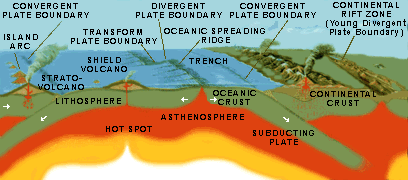|
Tectonic Plate Motion
 | | Cross-sectional view of the Earth's lithosphere and lower mantle. Also, the figure annotates Earth's three different tectonic plate boundaries: convergent, divergent and transform. Figure source: http://geology.er.usgs.gov/eastern/tectonic.html |
There are three types of motions between the tectonic plates: divergence, convergence, and lateral. The Galapagos contains three types of plate boundaries. Divergent and transform plate boundaries are located within the archipelago, while a convergent boundary exists directly off the coast of Ecuador.
Divergent Boundaries occur where two plates move apart and new crust is formed from magma generated in the mantle below. Younger rocks are located at the boundary whereas the older rocks move farther and farther away. Divergent boundaries are also known as spreading centers and generate an underwater mountain chain which encircles the earth much like the seams of a baseball. Spreading centers also rift apart continents, allowing oceans to form between them. For example, the Mid-Atlantic Ridge is the focus of rifting that seperated North and South America from Europe and Africa and formed the Atlantic ocean.
Oceanic-continent convergent boundaries occur when the dense oceanic crust approaches the buoyant continent and the ocean crust sinks below the continent. At an estimated depth of 100 km the crust melts and rises as magma, forming strata volcanoes on the surface directly above. This process is known as subduction and deep trenches are created by this process. Great amounts of stress are produced along these boundaries and build up over time, producing some of the world's most intense earthquakes.
Oceanic-oceanic convergence involves similar processes. With the collision of two oceanic plates, subduction still occurs. Magma created by the melting crust rises to the surface creating chains of volcanoes, known as island arcs. A well-noted example of an island arc is the Alleutian Islands.
Continental-continental convergence produces different results. When two continental plates converge, collision occurs. The continent buckles, squeezes, folds, thrusts, and deforms. Large-scale mountain building results from the intense collision. The Himalayan mountain range is the most recognized continent-continent collision.
Transform boundaries occur where two plates slide past each other horizontally. These boundaries are usually faults that offset and connect spreading centers. Many transform boundaries are found on the ocean floors, the San Andreas Fault in California is the most recognized transform boundary located on land. Large earthquakes occur along these boundaries as the plates grind by each other.
|







